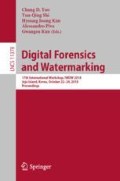Abstract
Synthetic data and generative models have been more and more popular with the rapid development of machine learning and artificial intelligence (AI). Consequently, generative steganography, a novel steganographic method finishing the operation of steganography directly in the process of image generation, tends to get more attention. However, most of the existing generative steganographic methods have more or less shortcomings, such as low security, small capacity or limited to certain images. In this paper, we propose a novel framework for generative steganography based on autoregressive model, or rather, PixelCNN. Theoretical derivation has been taken to prove the security of the framework. A simplified version is also proposed for binary embedding with lower complexity, for which the experiments show that the proposed method can resist the existing steganalytic methods.
This work was supported in part by the National Natural Science Foundation of China under Grant U1636201 and 61572452.
Access this chapter
Tax calculation will be finalised at checkout
Purchases are for personal use only
References
Filler, T., Fridrich, J.: Gibbs construction in steganography. IEEE Trans. Inf. Forensics Secur. 5(4), 705–720 (2010)
Holub, V., Fridrich, J.: Designing steganographic distortion using directional filters. In: 2012 IEEE International Workshop on Information Forensics and Security (WIFS), pp. 234–239. IEEE (2012)
Holub, V., Fridrich, J.: Digital image steganography using universal distortion. In: Proceedings of the First ACM Workshop on Information Hiding and Multimedia Security, pp. 59–68. ACM (2013)
Li, B., Wang, M., Huang, J., Li, X.: A new cost function for spatial image steganography. In: 2014 IEEE International Conference on Image Processing (ICIP), pp. 4206–4210. IEEE (2014)
Sedighi, V., Cogranne, R., Fridrich, J.: Content-adaptive steganography by minimizing statistical detectability. IEEE Trans. Inf. Forensics Secur. 11(2), 221–234 (2016)
Pevny, T., Bas, P., Fridrich, J.: Steganalysis by subtractive pixel adjacency matrix. IEEE Trans. Inf. Forensics Secur. 5(2), 215–224 (2010)
Fridrich, J., Kodovsky, J.: Rich models for steganalysis of digital images. IEEE Trans. Inf. Forensics Secur. 7(3), 868–882 (2012)
Denemark, T., Sedighi, V., Holub, V., Cogranne, R., Fridrich, J.: Selection-channel-aware rich model for steganalysis of digital images. In: 2014 IEEE International Workshop on Information Forensics and Security (WIFS), pp. 48–53. IEEE (2014)
Guanshuo, X., Han-Zhou, W., Shi, Y.-Q.: Structural design of convolutional neural networks for steganalysis. IEEE Signal Process. Lett. 23(5), 708–712 (2016)
Kingma, D.P., Welling, M.: Auto-encoding variational bayes. arXiv preprint arXiv:1312.6114 (2013)
Goodfellow, I.: Generative adversarial nets. In: Advances in Neural Information Processing Systems, pp. 2672–2680 (2014)
Larochelle, H., Murray, I.: The neural autoregressive distribution estimator. In: Proceedings of the Fourteenth International Conference on Artificial Intelligence and Statistics, pp. 29–37 (2011)
Theis, L., Bethge, M.: Generative image modeling using spatial LSTMs. In: Advances in Neural Information Processing Systems, pp. 1927–1935 (2015)
van den Oord, A., Kalchbrenner, N., Kavukcuoglu, K.: Pixel recurrent neural networks. arXiv preprint arXiv:1601.06759 (2016)
Hayes, J., Danezis, G.: Generating steganographic images via adversarial training. In: Advances in Neural Information Processing Systems, pp. 1951–1960 (2017)
Wu, K.-C., Wang, C.-M.: Steganography using reversible texture synthesis. IEEE Trans. Image Process. 24(1), 130–139 (2015)
Zhou, Z., Sun, H., Harit, R., Chen, X., Sun, X.: Coverless image steganography without embedding. In: Huang, Z., Sun, X., Luo, J., Wang, J. (eds.) ICCCS 2015. LNCS, vol. 9483, pp. 123–132. Springer, Cham (2015). https://doi.org/10.1007/978-3-319-27051-7_11
van den Oord, A., Kalchbrenner, N., Espeholt, L., Vinyals, O., Graves, A., et al.: Conditional image generation with pixelCNN decoders. In: Advances in Neural Information Processing Systems, pp. 4790–4798 (2016)
Salimans, T., Karpathy, A., Chen, X., Kingma, D.P.: PixelCNN++: improving the pixelCNN with discretized logistic mixture likelihood and other modifications. arXiv preprint arXiv:1701.05517 (2017)
Triantafyllidis, G.A., Strintzis, M.G.: A context based adaptive arithmetic coding technique for lossless image compression. IEEE Signal Process. Lett. 6(7), 168–170 (1999)
https://en.wikipedia.org/wiki/Rejection_sampling#Advantages_over_sampling_using_naive_methods
Hopper, N.J., Langford, J., von Ahn, L.: Provably secure steganography. In: Yung, M. (ed.) CRYPTO 2002. LNCS, vol. 2442, pp. 77–92. Springer, Heidelberg (2002). https://doi.org/10.1007/3-540-45708-9_6
Frey dataset. http://www.cs.nyu.edu/~roweis/data/frey_rawface.mat
Anime dataset. https://drive.google.com/file/d/1yOrpEjEYU8LXl8h-k7gVaaQ0ZdGYfnU_/view?usp=sharing
Volkhonskiy, D., Borisenko, B., Burnaev, E.: Generative adversarial networks for image steganography (2016)
Shi, H., Dong, J., Wang, W., Qian, Y., Zhang, X.: SSGAN: Secure steganography based on generative adversarial networks. arXiv preprint arXiv:1707.01613 (2017)
Author information
Authors and Affiliations
Corresponding author
Editor information
Editors and Affiliations
Rights and permissions
Copyright information
© 2019 Springer Nature Switzerland AG
About this paper
Cite this paper
Yang, K., Chen, K., Zhang, W., Yu, N. (2019). Provably Secure Generative Steganography Based on Autoregressive Model. In: Yoo, C., Shi, YQ., Kim, H., Piva, A., Kim, G. (eds) Digital Forensics and Watermarking. IWDW 2018. Lecture Notes in Computer Science(), vol 11378. Springer, Cham. https://doi.org/10.1007/978-3-030-11389-6_5
Download citation
DOI: https://doi.org/10.1007/978-3-030-11389-6_5
Published:
Publisher Name: Springer, Cham
Print ISBN: 978-3-030-11388-9
Online ISBN: 978-3-030-11389-6
eBook Packages: Computer ScienceComputer Science (R0)

